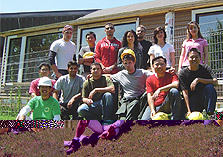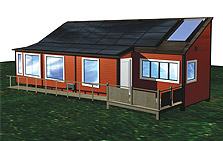

Team Canada takes a break to enjoy a sunny moment in front of its winter-ready house.

Sleek rooftop PV panels are just one example of team Canada's invisible-technology approach.
Solar Decathlon 2005
Canadian Solar
Concordia University and Université de Montréal
Smart House for a Cold Climate
In chilly Montreal, the appearance of the sun in winter is a welcome sight for more than one reason. "We hope to use weather prediction and smart controls as much as possible to effectively control the home," says Mark Pasini, Canadian Decathlon team project manager.
The Canadian Solar Decathlon team, made up of building, electrical, civil, and mechanical engineering students from Concordia University and industrial and architectural design students from L'Université de Montréal, set out to design a high-tech house in which most of the technology is invisible, seamlessly integrated through a special home automation system. The automation system monitors the home's temperature and links to controls throughout the house.
To help with designing the automation system and other aspects of the house, team members designed their own software to simulate the thermal behavior of the house. The software combines all the unique components of the house, including the automated blinds and the thermal storage. Phase-change materials and a wall of water placed adjacent to window glass serve as thermal storage and perpetuate the house's invisible-technology design approach.
The solar panels are also intended to be an unobtrusive, if not nearly invisible, technological feature. "People may not even realize they are solar panels," says Pasini. Whereas some PV systems are almost a double roofing system, the Canadian team's PV panel is basically an energy-generating roofing material.
Tight walls, lots of thermal storage, and plenty of foam insulation are important ingredients in this home built for a harsh, northern climate. But the students also boldly designed their house with large windows on the south-facing facade. Of course, the windows are triple glazed for the cold climate.
In addition to the need to design for a colder climate than many of the other schools, the Canadians also have other unusual responsibilities. The first is getting their house through U.S. customs, which requires extensive documentation of the materials they bring to the competition in Washington, D.C. And, finally, the students are proud to represent a larger constituency than most teams. Says Robert Moussa, student and leader of the electrical/PV team, "We are the only team from Canada, and so we feel we are representing a whole nation."
Team Contact
Prof. Andreas K. Athienitis
1257 Rue Guy
Montréal, Quebec
H3G 1M8, Canada
514-848-2424, ext. 8791
